Designing the Adaptive Landscape: Leapfrogging Stacked Vulnerabilities
Abstract
:1. Introduction
2. Problem Definition
2.1. Problem Exploration
2.1.1. Ecology
2.1.2. Agriculture
2.1.3. Flood Safety
2.1.4. Stacked Vulnerabilities
2.2. Problem Definition
3. Methodology
- 0.
- Analysis of current policies: Desk-top study on future healthy food demand, agricultural productivity and economic feasibility of future agriculture, and water requirements and availability. Based in existing sources, statistics, and predictions, problems are quantified.
- 1.
- 2.
- 3.
- Planning an integrated spatial future of the landscape, using backcasting methods [48,49] and scenario planning [50,51,52] to explore the corners of future predictions for the agricultural system (local vs. global), climate change (accelerated change vs. realizing the Paris agreement), and ecology (biodiversity loss vs. ecological regeneration).
- 4.
- 5.
4. Results
4.1. Current Policies
4.2. The Long View
4.3. A Holistic Intervention and Integrated Spatial Vision
4.4. Impact on Land Use
4.4.1. Ecology
4.4.2. Food
4.4.3. Safety
4.5. A staged Future
5. Discussion
6. Conclusions
Author Contributions
Funding
Institutional Review Board Statement
Informed Consent Statement
Conflicts of Interest
References
- IPCC. Climate Change 2014: Synthesis Report. Contribution of Working Groups I, II and III to the Fifth Assessment Report of the Intergovernmental Panel on Climate Change; Core Writing Team, Pachauri, R.K., Meyer, L.A., Eds.; IPCC: Geneva, Switzerland, 2014; p. 151. [Google Scholar]
- Crutzen, P.J. Geology of mankind. Nature 2002, 415, 23. [Google Scholar] [CrossRef]
- IPCC. IPCC Special Report on Climate Change, Desertification, Land Degradation, Sustainable Land Management, Food Security, and Greenhouse Gas Fluxes in Terrestrial Ecosystems. Summary for Policymakers; Approved Draft; IPCC: Geneva, Switzerland, 2019; Available online: https://www.ipcc.ch/report/srccl/ (accessed on 10 August 2020).
- IPBES. Summary for Policymakers of the Global Assessment Report on Biodiversity and Ecosystem Services of the Intergovernmental Science-Policy Platform on Biodiversity and Ecosystem Services; Díaz, J.S., Settele, E.S., Brondizio, E.S., Ngo, H.T.M., Guèze, J., Agard, A., Arneth, P., Balvanera, K.A., Brauman, S.H.M., et al., Eds.; IPBES-Secretariat: Bonn, Germany, 2019. [Google Scholar]
- Orr Roberts, W. Climate change and the quality of life for the earth’s new millions. Proc. Am. Philos. Soc. 1976, 120, 230–232. Available online: https://www.jstor.org/stable/986562 (accessed on 21 December 2020).
- Mupedziswa, R.; Kubanga, K.P. Climate change, urban settlements and quality of life: The case of the Southern African Development Community region. Dev. S. Afr. 2016, 34, 196–209. [Google Scholar] [CrossRef]
- Liang, L.; Deng, X.; Wang, P.; Wang, Z.; Wang, L. Assessment of the impact of climate change on cities livability in China. Sci. Total. Environ. 2020, 726, 138339. [Google Scholar] [CrossRef] [PubMed]
- Lindsey, R. Climate Change: Global Sea Level. Climate.gov. 2018. Available online: https://www.climate.gov/news-features/understanding-climate/climate-change-global-sea-level (accessed on 27 July 2020).
- Haasnoot, M.; Bouwer, L.; Diermanse, F.; Kwadijk, J.; Van der Spek, A.; Oude Essink, G.; Delsman, J.; Weiler, O.; Mens, M.; Ter Maat, J.; et al. Mogelijke Gevolgen van Versnelde Zeespiegelstijging voor het Deltaprogramma. Een Verkenning. Deltares Rapport 11202230-005-0002; Deltares: Delft, The Netherlands, 2018. [Google Scholar]
- Rockström, J.; Steffen, W.; Noone, K.; Persson, Å.; Chapin, F.S.; Lambin, E.F.; Lenton, T.M.; Scheffer, M.; Folke, C.; Schellnhuber, H.J.; et al. A safe operating space for humanity. Nature 2009, 461, 472–475. [Google Scholar] [CrossRef] [PubMed]
- Schipper, E.L.F.; Burton, I. (Eds.) Adaptation to Climate Change; Earthscan: London, UK, 2009. [Google Scholar]
- Global Commission on Adaptation Adapt Now: A Global Call for Leadership on Climate Resilience; Global Center on Adaptation, Groningen/Rotterdam and World Resources Institute: Washington, DC, USA, 2019.
- Schubert, D. Cities and plans—The past defines the future. Plan. Perspect. 2019, 34, 3–23. [Google Scholar] [CrossRef]
- Molotch, H.; Freudenburg, W.; Paulsen, K. History repeats itself, but how? City character, urban tradition, and the accom-plishment of place. Am. Sociol. Rev. 2000, 65, 791–823. Available online: http://www.jstor.org/stable/2657514 (accessed on 21 December 2020). [CrossRef]
- Lindblom, C.E. The science of “muddling through”. Public Adm. Rev. 1959, 19, 79–88. [Google Scholar] [CrossRef]
- Roggema, R.; Genel Altinkaya, Ö.; Psarra, I. De Toukomst is Al Lang Begonnen; Hanze University of Applied Sciences Groningen: Groningen, The Netherlands, 2020. [Google Scholar]
- Roggema, R. Bypassing the obvious: Implementing cutting edge ideas for futuring urban landscapes. Urban Reg. Plan. 2021, 6, 1–14. [Google Scholar] [CrossRef]
- Merry, U. Coping with Uncertainty. Insights from the New Sciences of Chaos, Self-Organisation and Complexity; Praeger Publishers: Westport, CT, USA, 1995. [Google Scholar]
- Schwarz, P. The Art of the Long View. Planning for the Future in San Uncertain World; Bantam Doubleday Dell Publishing Group Inc.: New York, NY, USA, 1991. [Google Scholar]
- Davy, B. Plan it without a condom! Plan. Theory 2008, 7, 301–317. [Google Scholar] [CrossRef]
- Roggema, R. Adaptation to Climate Change: A Spatial Challenge; Springer: Dordrecht, The Netherlands, 2009. [Google Scholar]
- Wrigley, C. Principles and practices of a design-led approach to innovation. Int. J. Des. Creativity Innov. 2017, 5, 235–255. [Google Scholar] [CrossRef]
- Balz, V. Regional Design. Discretionary Approaches to Planning in The Netherlands. Ph.D. Thesis, Delft University of Technology, Delft, The Netherlands, 2019. [Google Scholar]
- Yan, W.; Roggema, R. Developing a design-led approach for the food-energy-water nexus in cities. Urban. Plan. 2019, 4, 123–138. [Google Scholar] [CrossRef] [Green Version]
- WWF. Living Planet Report 2020—Bending the Curve of Biodiversity Loss; Almond, R.E.A., Grooten, M., Petersen, T., Eds.; WWF: Gland, Switzerland, 2020. [Google Scholar]
- Provincie Groningen De Toestand van Natuur en Landschap in de Provincie Groningen, 2017 Achtergronddocuent. Available online: https://destaatvangroningen.nl/uploads/toestand-van-natuur-en-landschap-achtergronddocument.pdf (accessed on 15 June 2020).
- CBS; PBL; RIVM; WUR. Boerenlandvogels, 1915–2018. Centraal Bureau voor de Statistiek (CBS), Den Haag; PBL Planbureau voor de Leefomgeving, Den Haag; RIVM Rijksinstituut voor Volksge-zondheid en Milieu, Bilthoven; Wageningen University and Research: Wageningen, The Netherlands, 2020; Available online: www.clo.nl (accessed on 5 February 2020).
- Teunissen, W.L. Soldaat Indexen en Trends van een Aantal Weidevogelsoorten uit het Weidevogelmeetnet. Periode 1990–2004. SOVON-Informatie 2005/13; SOVON Vogelonderzoek Nederland: Beek-Ubbergen, The Netherlands, 2005. [Google Scholar]
- Statline. Available online: www.statline.cbs.nl (accessed on 23 December 2020).
- Van Well, E.; Rougoor, C. Landbouw en Klimaatverandering in Groningen; CLM-Report CLM-904; CLM: Culemborg, The Netherlands, 2016. [Google Scholar]
- Ministerie van LNV Europese Landbouw—Beleid. Toelichting Op De Betalingen In Het Kader Van Het Gemeenschappelijk Landbouwbeleid in Het Boekjaar 2019; Ministerie van LNV: Den Haag, The Netherlands, 2019. [Google Scholar]
- Rosegrant, M.W.; Cline, S.A. Global food security: Challenges and policies. Science 2003, 302, 1917–1919. [Google Scholar] [CrossRef] [Green Version]
- World Health Organization. Food Safety Risk Analysis: A Guide for National Food Safety Authorities; WHO; FAO: Rome, Italy, 2006. [Google Scholar]
- Van Staveren, G.; Velstra, J. Verzilting van Landbouwgronden in Noord-Nederland in het Perspectief van de Effecten van Klimaatverandering; Onderzoeksprogramma Klimaat voor Ruimte/Climate Changes Spatial Planning: Den Haag, The Netherlands, 2012. [Google Scholar]
- De Vries, S. Increasing Drought: A New Enemy for The Netherlands. Available online: https://www.the-low-countries.com/article/increasing-drought-a-new-enemy-for-the-netherlands (accessed on 20 August 2020).
- Van der Woud, A. Het Landschap de Mensen. Nederland 1850–1940; Prometeus: Amsterdam, The Netherlands, 2020. [Google Scholar]
- Wiersma, J.; Nieuwhof, A. Het ontstaan van het terpen—En wierdenlandschap. In De Geschiedenis van Terpen—En Wierdenland: Een Verhaal in Ontwikkeling (Jaarverslagen van de Vereniging voor Terpenonderzoek); Nieuwhof, A., Nicolay, J., Wiersma, J., Eds.; Vereniging voor Terpenonderzoek: Groningen, The Netherlands, 2018; Volume 100, pp. 11–26. [Google Scholar]
- Ministerie van Verkeer en Waterstaat. Allerheiligenvloed 2006. Achtergrondverslag van de Stormvoed van 1 November 2006; RIKZ: Den Haag, The Netherlands, 2007. [Google Scholar]
- Delta Program Commissioner. Delta Program 2020. Continuing the Work on the Delta: Down to Earth, Alert, and Prepared; Ministry of Infrastructure and Water Management, Ministry of Agriculture, Nature, and Food Quality Ministry of the Interior and Kingdom Relations: Den Haag, The Netherlands, 2019. [Google Scholar]
- Van Eekelen, E.; Bouw, M. (Eds.) Building with Nature. Creating, Implementing and Upscaling Nature-Based Solutions; Nai010 Publishers: Rotterdam, The Netherlands, 2020. [Google Scholar]
- Kabat, P.; Fresco, L.O.; Stive, M.J.F.; Veerman, C.P.; Van Alphen, J.S.L.J.; Parmet, B.W.A.H.; Hazeleger, W.; Katsman, C.A. Dutch coasts in transition. Nat. Geosci. 2009, 2, 450–452. [Google Scholar] [CrossRef]
- Fry, T. Design Futuring; University of New South Wales Press: Sydney, Australia, 2009; pp. 71–77. [Google Scholar]
- Cornish, E. Futuring: The Exploration of the Future; World Future Society: Chicago IL, USA, 2004. [Google Scholar]
- Shipley, R.; Newkirk, R. Vision and visioning in planning: What do these terms really mean? Environ. Plan. B Plan. Des. 1999, 26, 573–591. [Google Scholar] [CrossRef]
- Gaffikin, F.; Sterrett, K. New visions for old cities: The role of visioning in planning. Plan. Theory Pract. 2006, 7, 159–178. [Google Scholar] [CrossRef]
- Roggema, R. Adaptation to climate change: Does spatial planning help? Swarm planning does! WIT Trans. Ecol. Environ. 2009, 127, 161–172. [Google Scholar]
- Gladwell, M. The Tipping Point: How Little Things Can Make a Big Difference; Little, Brown and Company: New York, NY, USA, 2000. [Google Scholar]
- Holmberg, J.; Robèrt, K.H. Backcasting—A framework for strategic planning. Int. J. Sustain. Dev. World Ecol. 2000, 7, 291–308. [Google Scholar] [CrossRef]
- Quist, J. Backcasting for a Sustainable Future: The Impact After 10 Years; Eburon Uitgeverij BV: Utrecht, The Netherlands, 2007. [Google Scholar]
- Van der Heijden, K. Scenarios: The Art of Strategic Conversation; John Wiley: New York, NY, USA, 1997. [Google Scholar]
- Shoemaker, P.J.H. Scenario Planning: A tool for strategic thinking. Sloan Manag. Rev. 1995, 37, 25–40. [Google Scholar]
- Ramirez, R.; Wilkinson, A. Strategic Reframing: The Oxford Scenario Planning Approach; Oxford University Press: Oxford, UK, 2016. [Google Scholar]
- De Jong, T.M. Kleine Methodologie voor Ontwerpend Onderzoek; BOOM Uitgevers: Amsterdam, The Netherlands, 1992. [Google Scholar]
- Hauberg, J. Research by design—A research strategy. Rev. Lusófona Arquit. Educ./Archit. Educ. J. 2011, 5, 46–56. [Google Scholar]
- Milburn, L.-A.S.; Brown, R.D. The relationship between research and design in landscape architecture. Landsc. Urban. Plan. 2003, 64, 47–66. [Google Scholar] [CrossRef] [Green Version]
- Roggema, R. Research by design: Proposition for a methodological approach. Urban. Sci. 2016, 1, 2. [Google Scholar] [CrossRef]
- Rosemann, J. The conditions of research by design in practice. In Research by Design: International Conference Faculty of Architecture Delft University of Technology in Co-Operation with the EAAE/AEEA November 1–3 2000: Proceedings A; Van Ouwerkerk, M., Rosemann, J., Eds.; Delft University Press: Delft, The Netherlands, 2001; pp. 63–68. [Google Scholar]
- Swann, C. Action research and the practice of design. Des. Issues 2002, 18, 49–61. [Google Scholar] [CrossRef]
- Wilson, A. Catastrophe Theory and Bifurcation (Routledge Revivals): Applications to Urban and Regional Systems; Routledge: London, UK, 2012. [Google Scholar]
- Adaptive water management: Integrated water management on the edge of chaos. Water Sci. Technol. 1995, 32, 7–13. [CrossRef]
- Roggema, R. Swarm planning: A new design paradigm dealing with long term problems associated with turbulence. In Business Planning for Turbulent Times, New Methods for Applying Scenarios; Ramirez, R., Selsky, J.W., Van der Heijden, K., Eds.; Earthscan: Abingdon, UK, 2008; pp. 103–129. [Google Scholar]
- Timmermans, W.; Ónega López, F.; Roggema, R. Complexity theory, spatial planning and adaptation to climate change. In Swarming Landscapes: The Art of Designing for Climate Adaptation; Roggema, R., Ed.; Springer: Dordrecht, The Netherlands, 2012; pp. 43–65. [Google Scholar]
- Jones, R. Detecting and attributing nonlinear anthropogenic regional warming in southeastern Australia. J. Geophys. Res. Space Phys. 2012, 117, 4. [Google Scholar] [CrossRef]
- Jones, R.; Ricketts, J.H. Reconciling the signal and noise of atmospheric warming on decadal timescales. Earth Syst. Dyn. 2017, 8, 177–210. [Google Scholar] [CrossRef] [Green Version]
- Condon, P.M. Design Charrettes for Sustainable Communities; Island Press: Washington, DC, USA, 2008. [Google Scholar]
- Lennertz, B.; Lutzenhiser, A. The Charrette Handbook. The Essential Guide for Accelerated Collaborative Community Planning; The American Planning Association: Chicago, IL, USA, 2006. [Google Scholar]
- Roggema, R.; Martin, J.; Horne, R. Sharing the climate adaptive dream: The benefits of the charrette approach. In Proceedings of the ANZRSAI Conference, Canberra, Australia, 6–9 December 2011; Dalziel, P., Ed.; AERU Research Unit: Canterbury, New Zealand, 2011. [Google Scholar]
- Roggema, R. (Ed.) The Design Charrette: Ways to Envision Sustainable Futures; Springer: London, UK; Dordrecht, The Netherlands, 2013. [Google Scholar]
- Cross, N. From a design science to a design discipline: Understanding designerly ways of knowing and thinking. In Design Research Now; Michel, R., Ed.; Birkhäuser: Basel, Switzerland, 2007; pp. 41–54. [Google Scholar] [CrossRef]
- Hocking, V.T. Designerly ways of knowing: What does design have to offer. In Tackling Wicked Problems Through the Transdisciplinary Imagination; Brown, V.A., Harris, J.A., Russell, J.Y., Eds.; Earthscan: Abingdon, UK, 2010; pp. 242–250. [Google Scholar]
- Sala, E. The Nature of Nature. Why We Need the Wild; National Geographic Partners, LLC: Washington, DC, USA, 2020. [Google Scholar]
- Santema, P.A. Voorraad Water Raakt op en er is Geen Alternatief. Leeuwarder Courant. 30 September 2020. Available online: https://www.lc.nl/friesland/Directeur-Wetsus-Voorraad-water-raakt-op-en-er-is-geen-alternatief-26062103.html?harvest_referrer=https%3A%2F%2Fwww.google.com%2F (accessed on 15 November 2020).
- Tree, I. Wilding, the Return of Nature to a British Farm; Picador: London, UK, 2018. [Google Scholar]
- Aan de Burgh, M. Zo leuk is de Natuur Niet Maar We Móéten er Iets Mee; NRC: Amsterdam, The Netherlands, 2020. [Google Scholar]
- Alkemade, F. De Toekomst van Nederland, de Kunst van Richting te Veranderen; Uitgeverij THOTH: Bussum, The Netherlands, 2020. [Google Scholar]
- Roggema, R.; Verheijden, B.; Hollanders, M.; Tillotson, R.; Fakhr Edin Alsharani, L. Moeder Zernike, Embracing a Natural Future; Hanze University of Applied Sciences: Groningen, The Netherlands, 2021. [Google Scholar]
- Willett, W.; Rockström, J.; Loken, B.; Springmann, M.; Lang, T.; Vermeulen, S.; Garnett, T.; Tilman, D.; Declerck, F.; Wood, A.; et al. Food in the Anthropocene: The EAT–Lancet Commission on healthy diets from sustainable food systems. Lancet 2019, 393, 447–492. [Google Scholar] [CrossRef]
- Van Oort, P.; Gou, F.; Stomph, T.-J.; Van Der Werf, W. Effects of strip width on yields in relay-strip intercropping: A simulation study. Eur. J. Agron. 2020, 112, 125936. [Google Scholar] [CrossRef]
- Glaze-Corcoran, S.; Hashemi, M.; Sadeghpour, A.; Jahanzad, E.; Keshavarz Afshar, R.; Liu, X.; Herbert, S.J. Understanding intercropping to improve agricultural resiliency and environmental sustainability. In Advances in Agronomy; Sparks, D.L., Ed.; Academic Press: Cambridge MA, USA, 2020; Volume 162, pp. 199–256. ISSN 0065-2113. ISBN 9780128207673. [Google Scholar] [CrossRef]
- UNEP. Decade on Restoration. 2020. Available online: https://www.decadeonrestoration.org (accessed on 24 January 2021).
- Cohen-Shacham, E.; Walters, G.; Janzen, C.; Maginnis, S. Nature-Based Solutions to Address Global Societal Challenges; IUCN: Gland, Switzerland, 2016. [Google Scholar]
- Gunderson, L.H.; Holling, C.S. Panarchy: Understanding Transformations in Human and Natural Systems; Island Press: Washington, DC, USA, 2002. [Google Scholar]

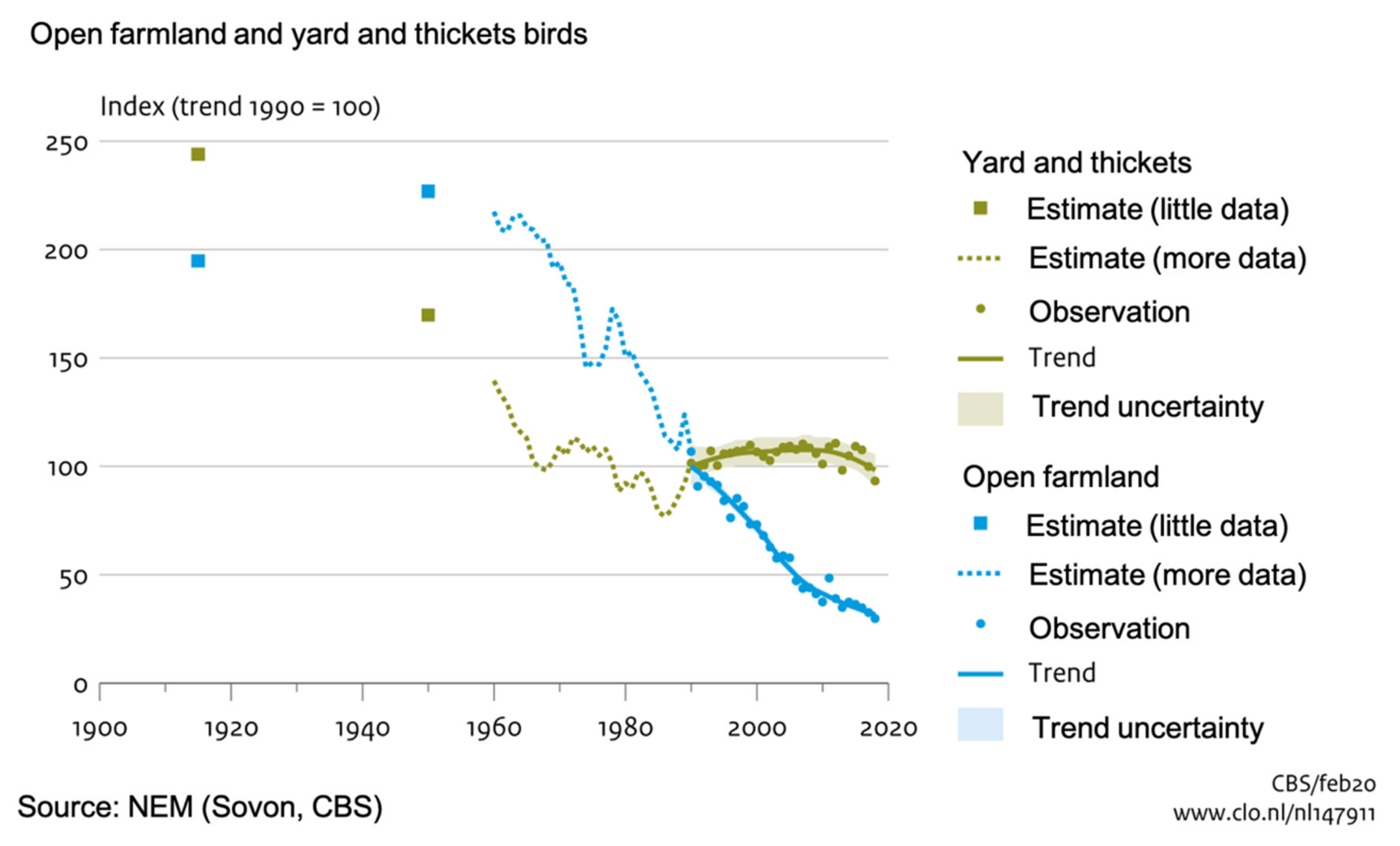
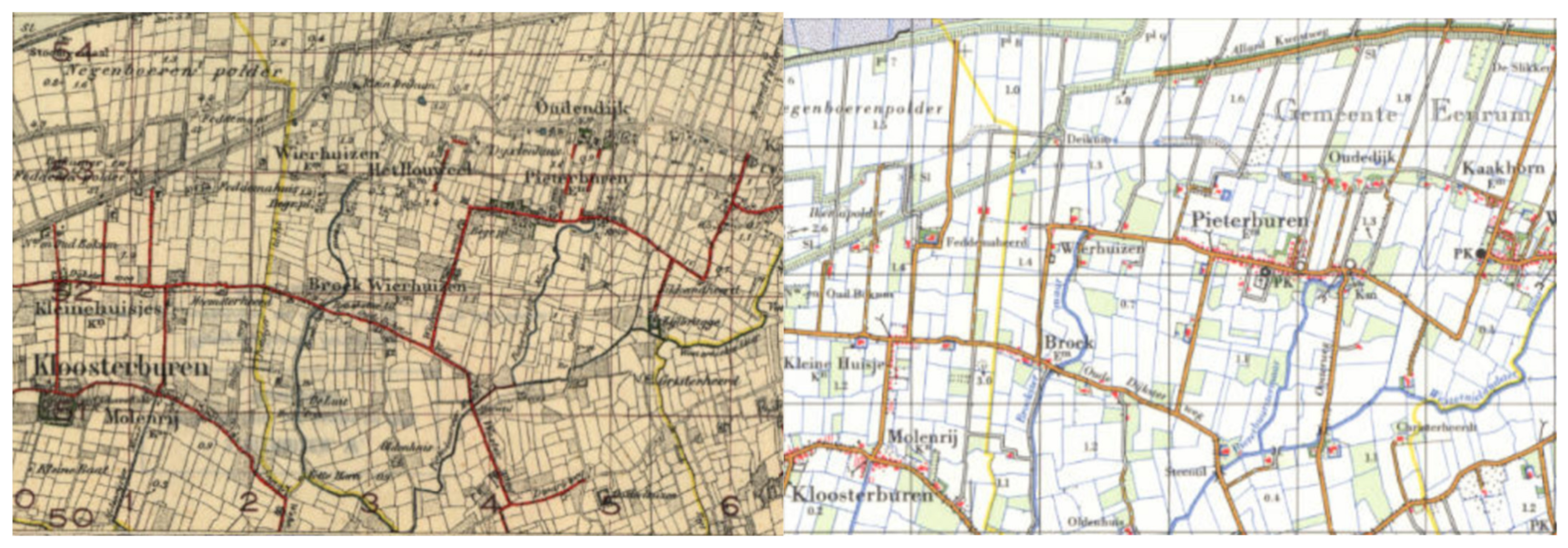
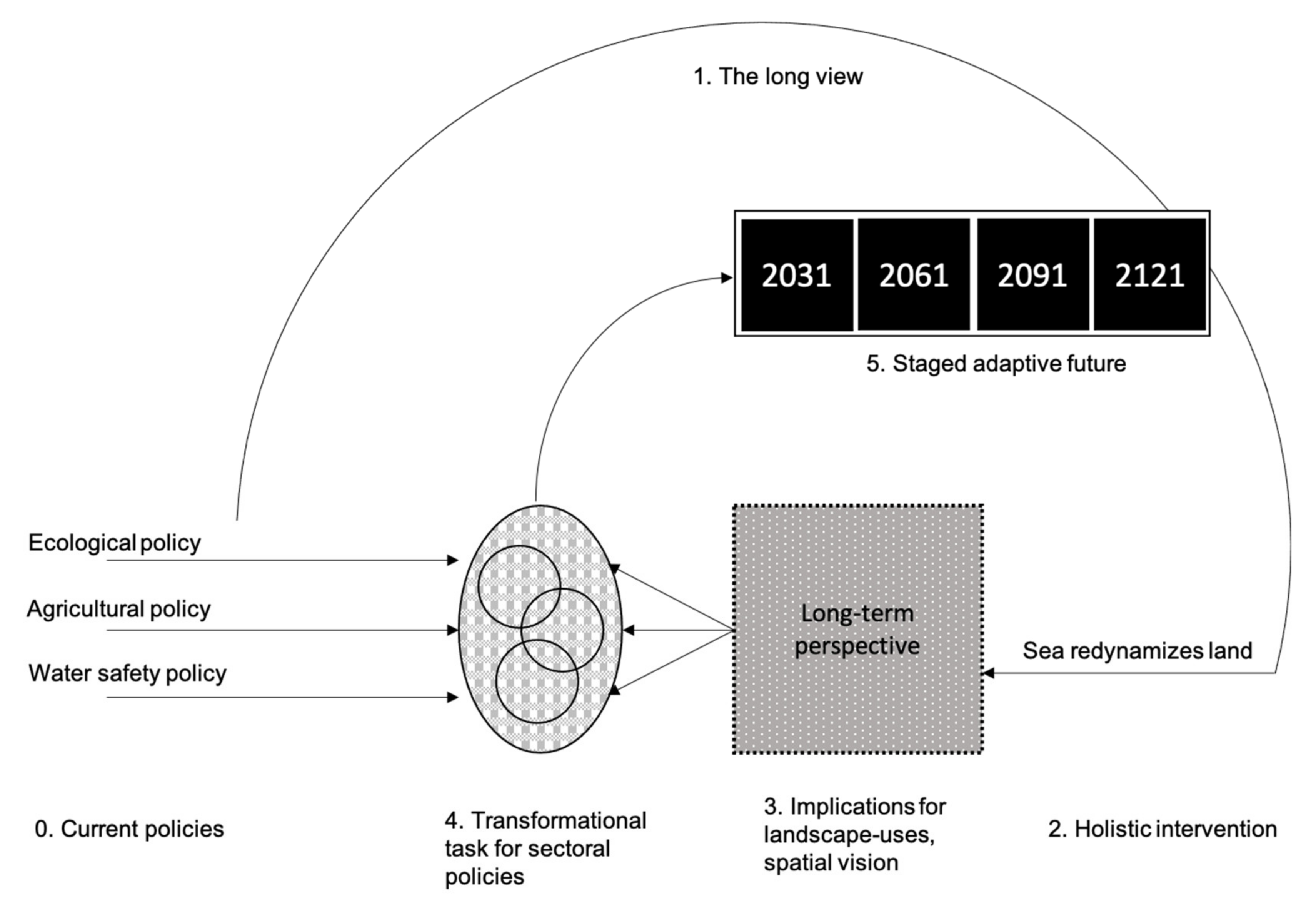
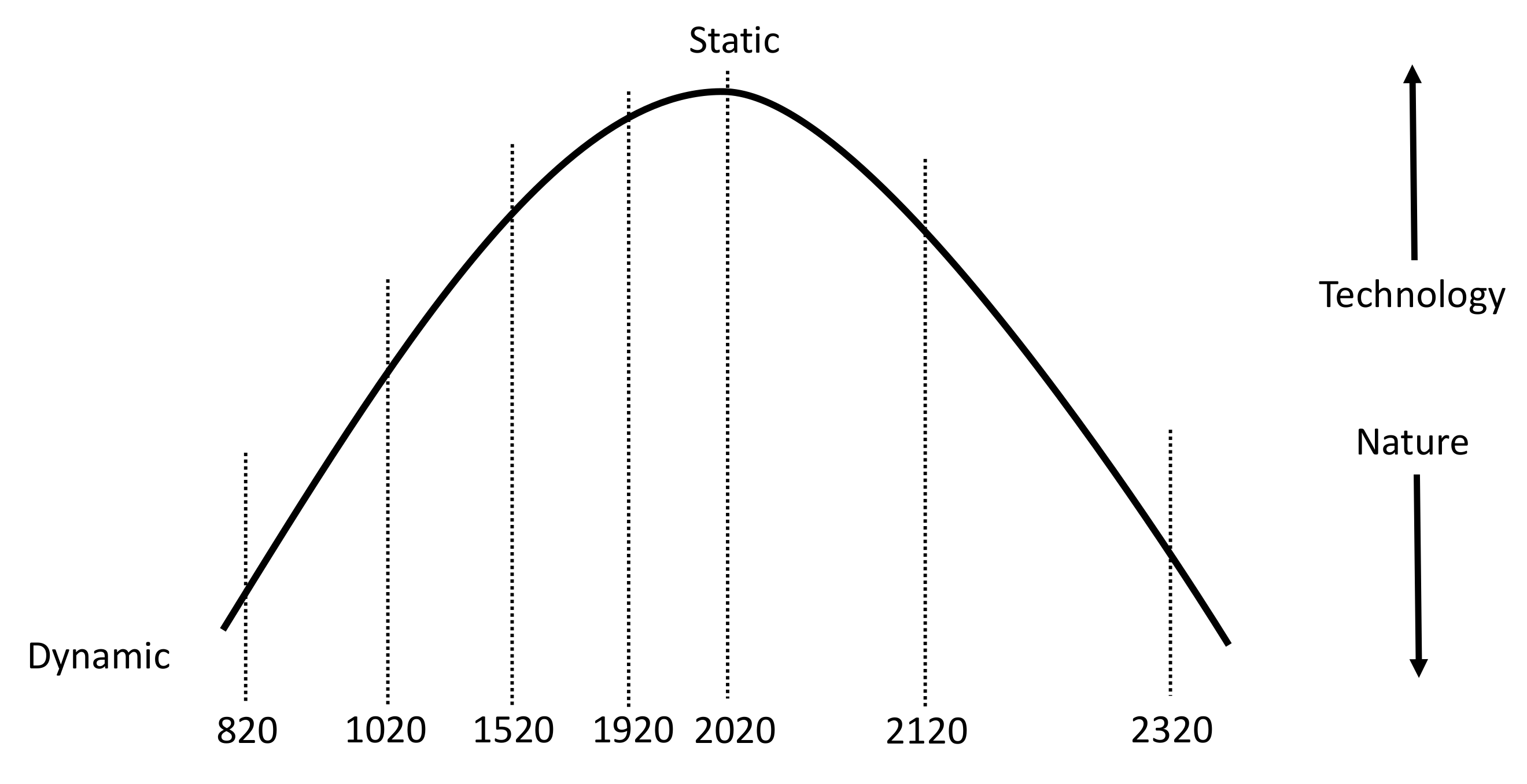
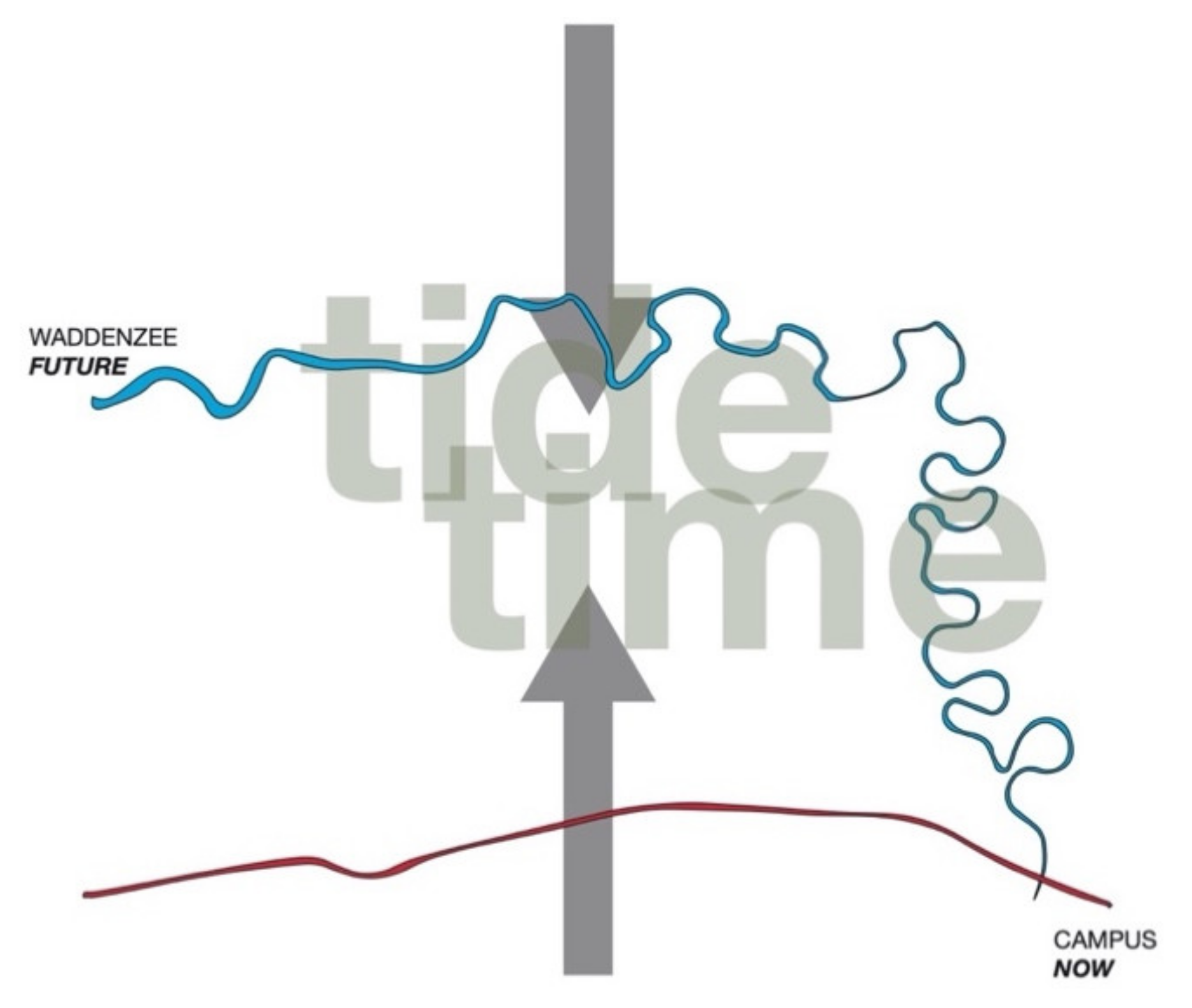

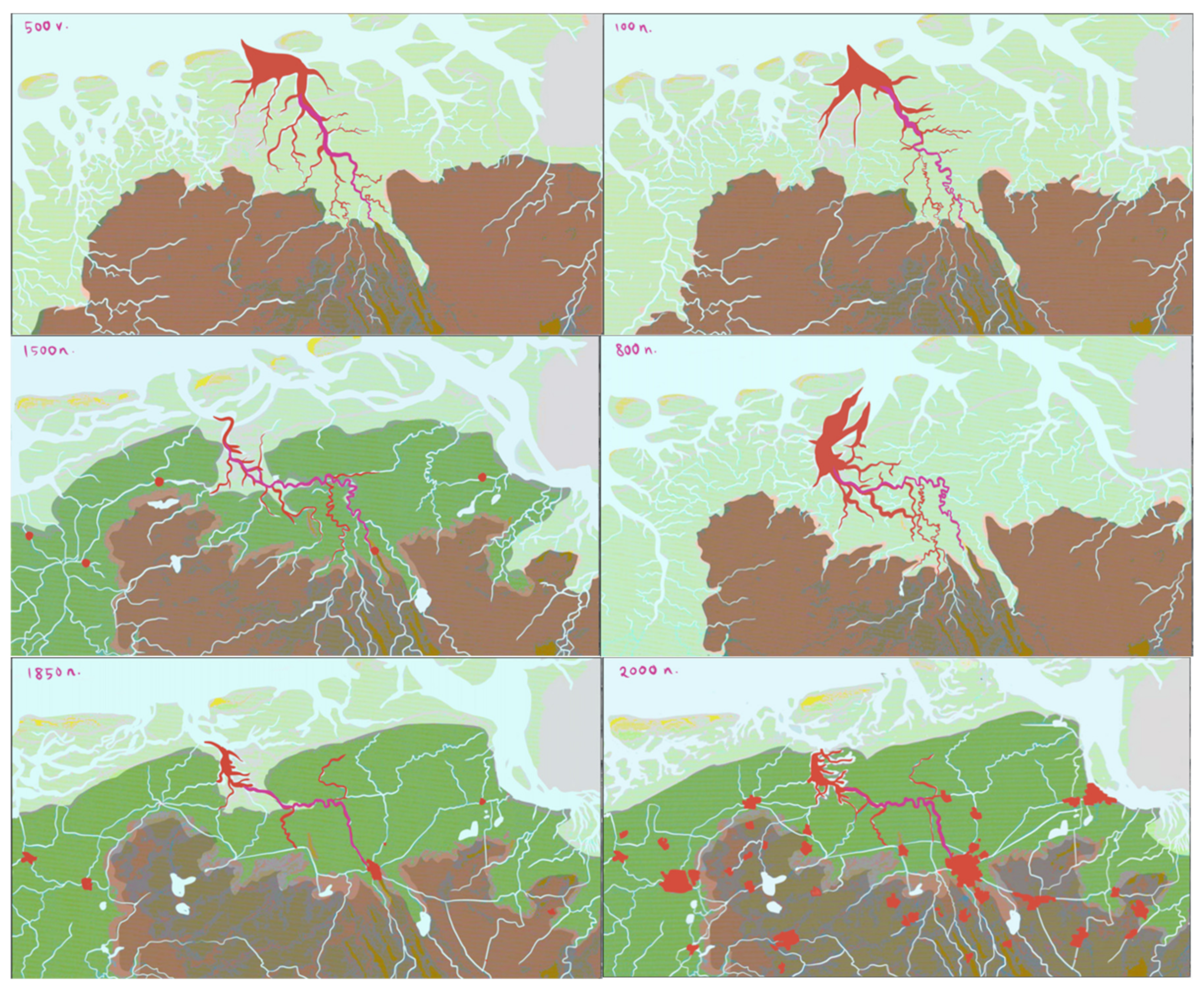

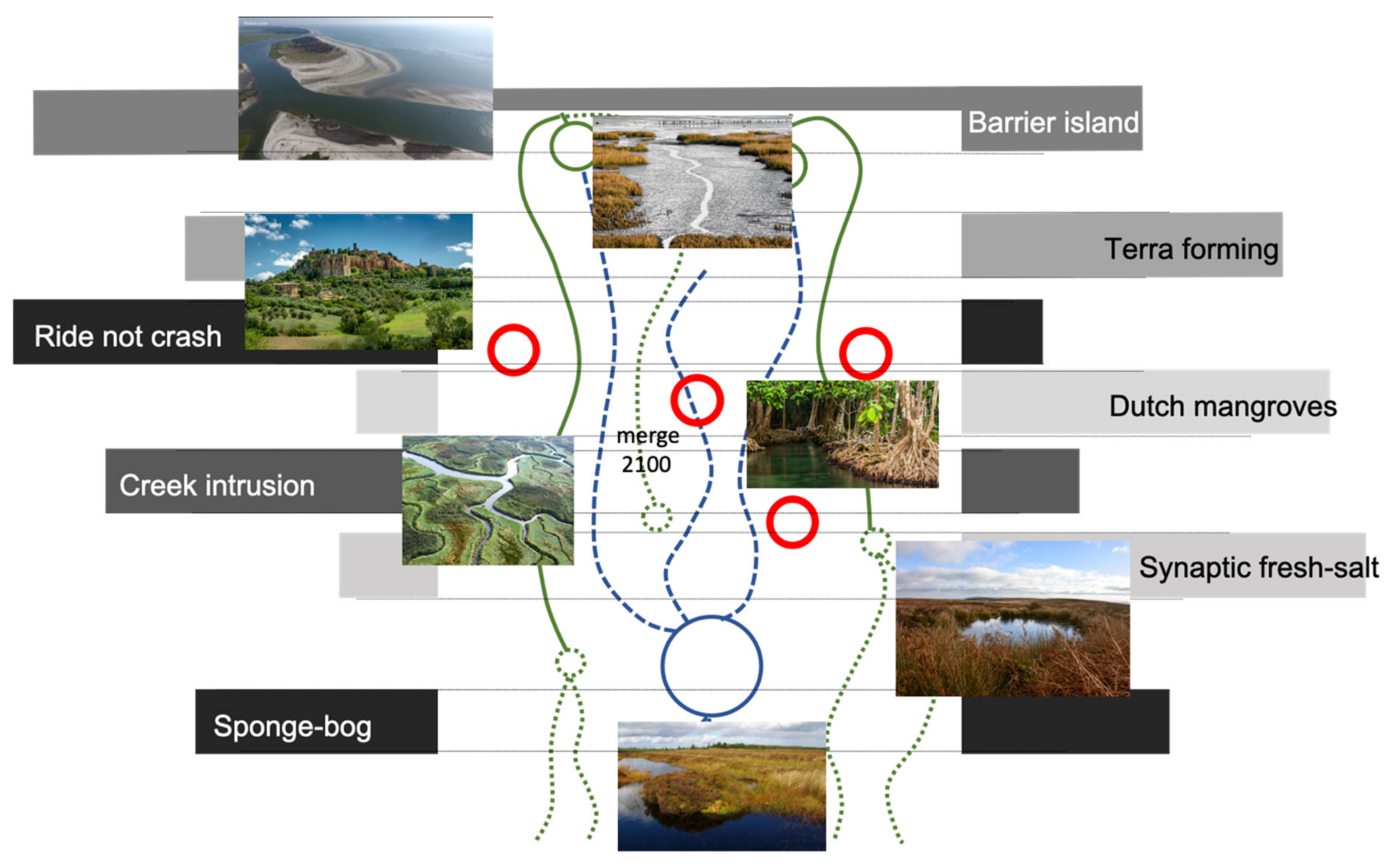

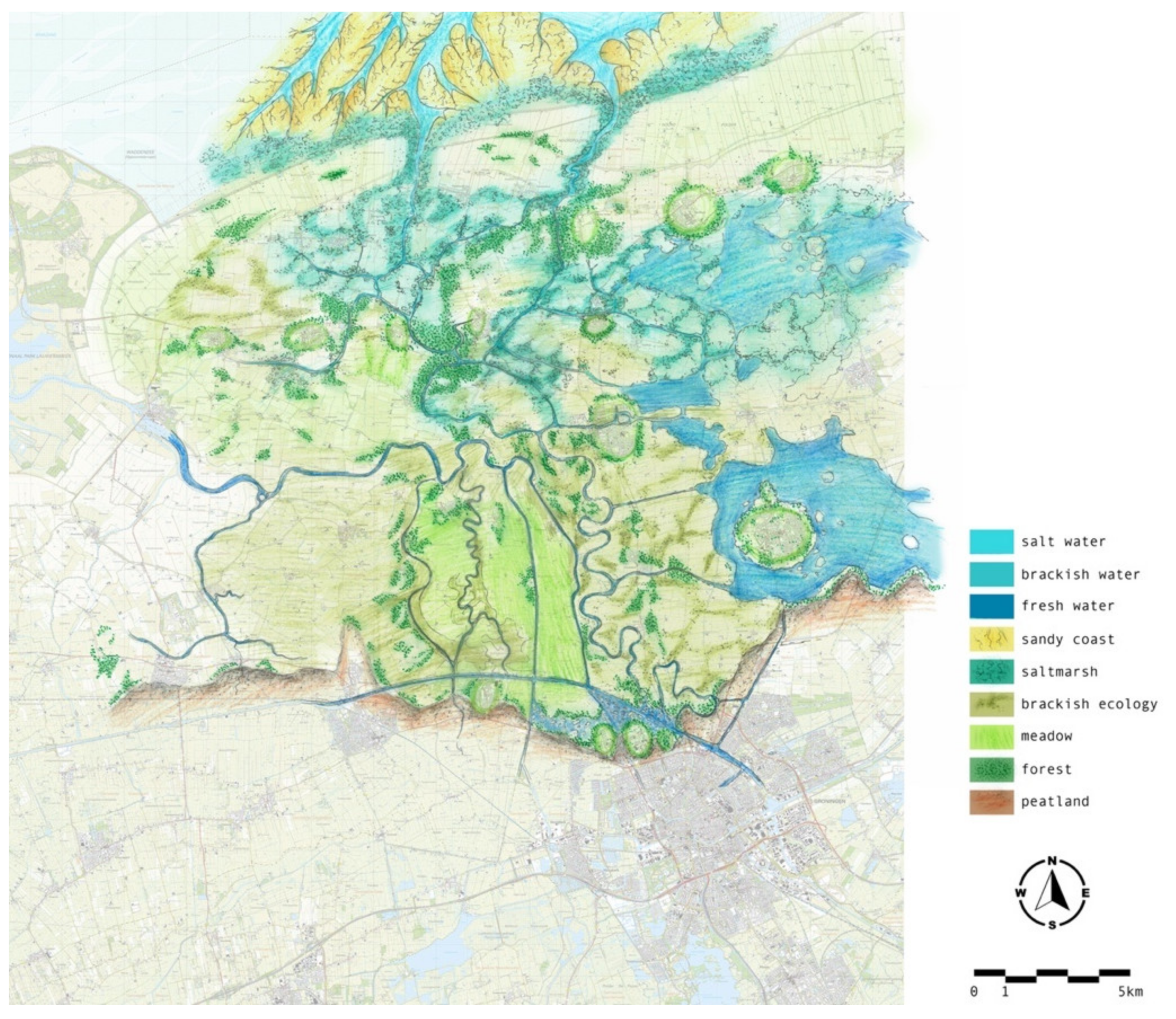

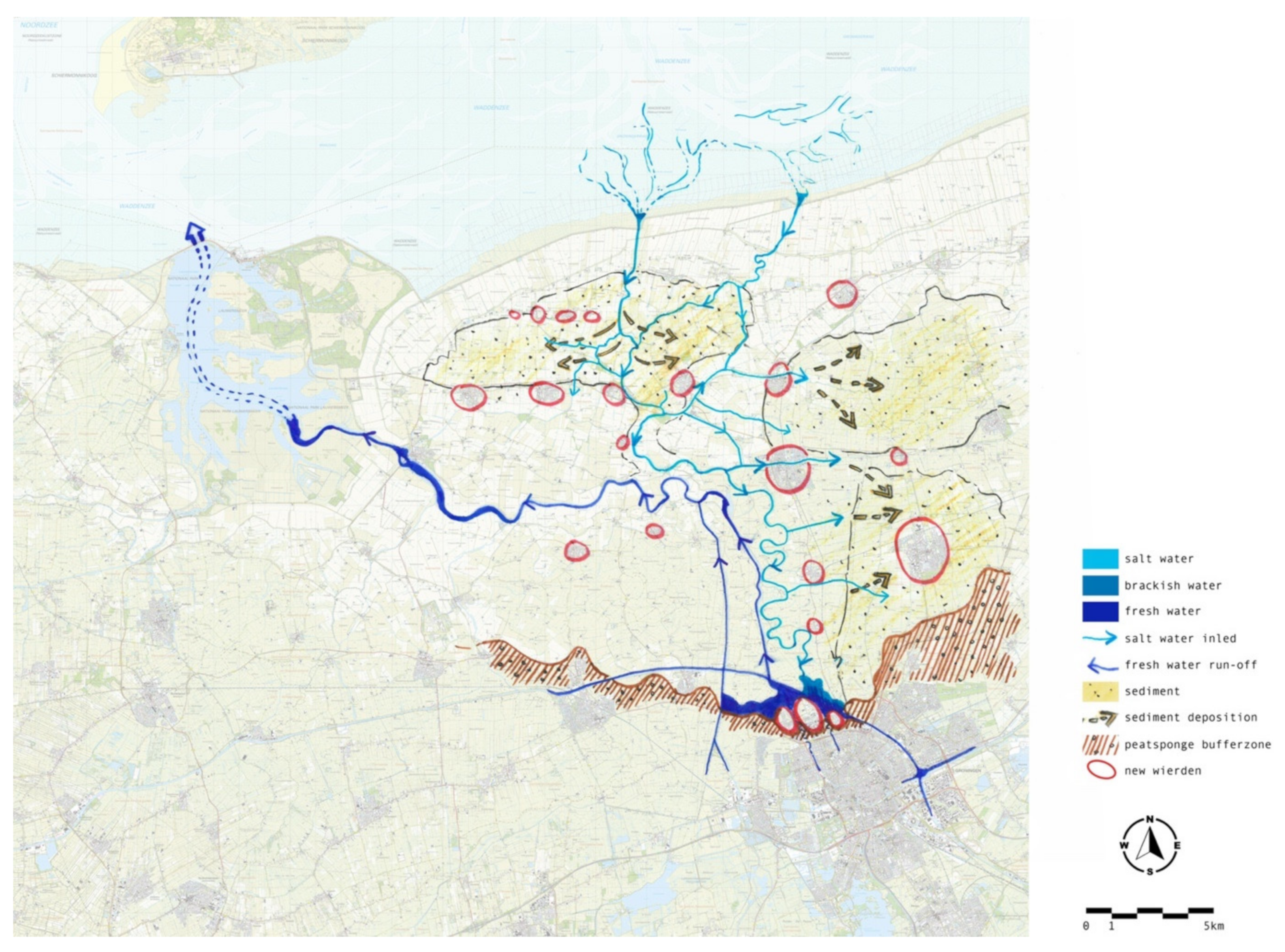

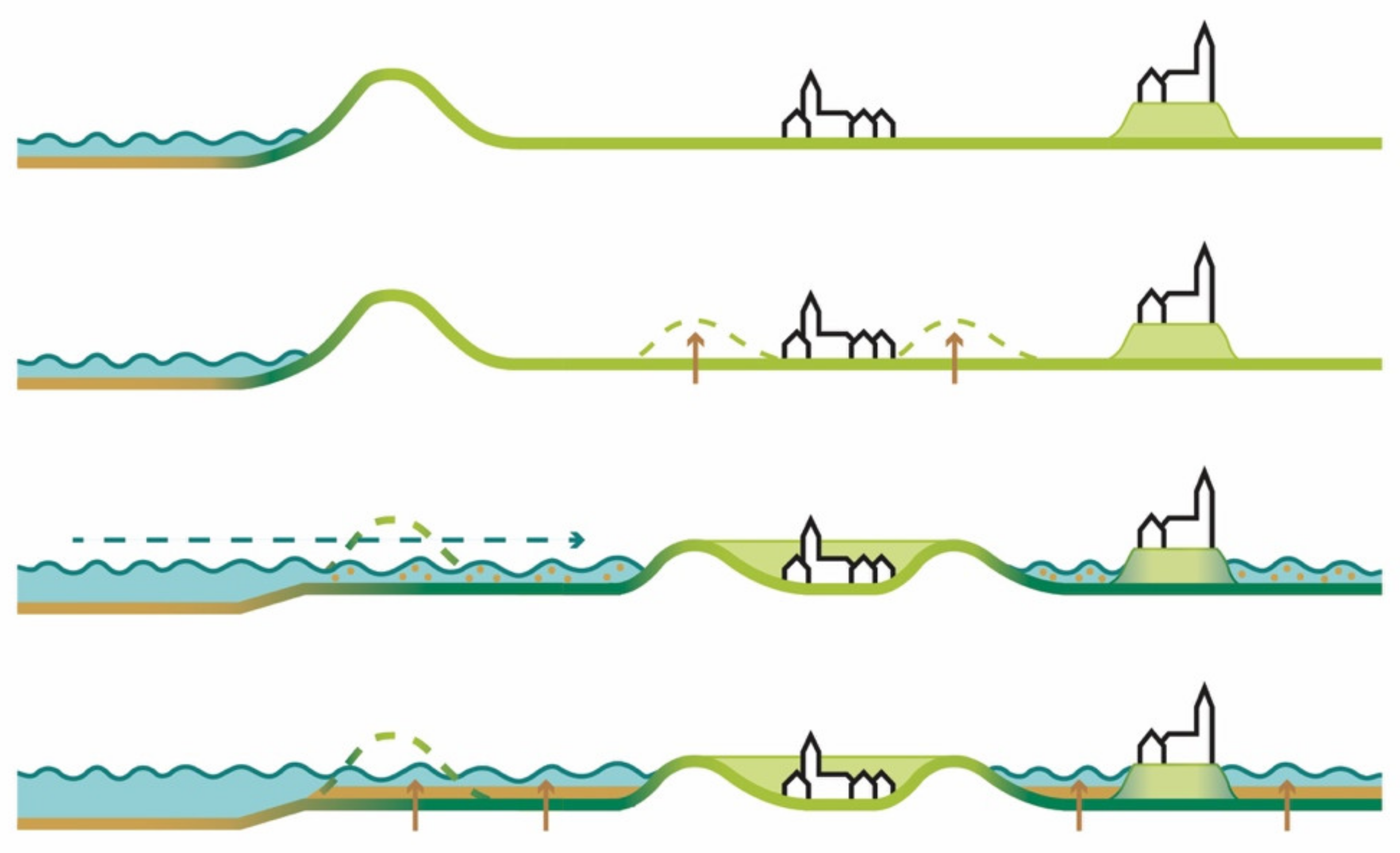
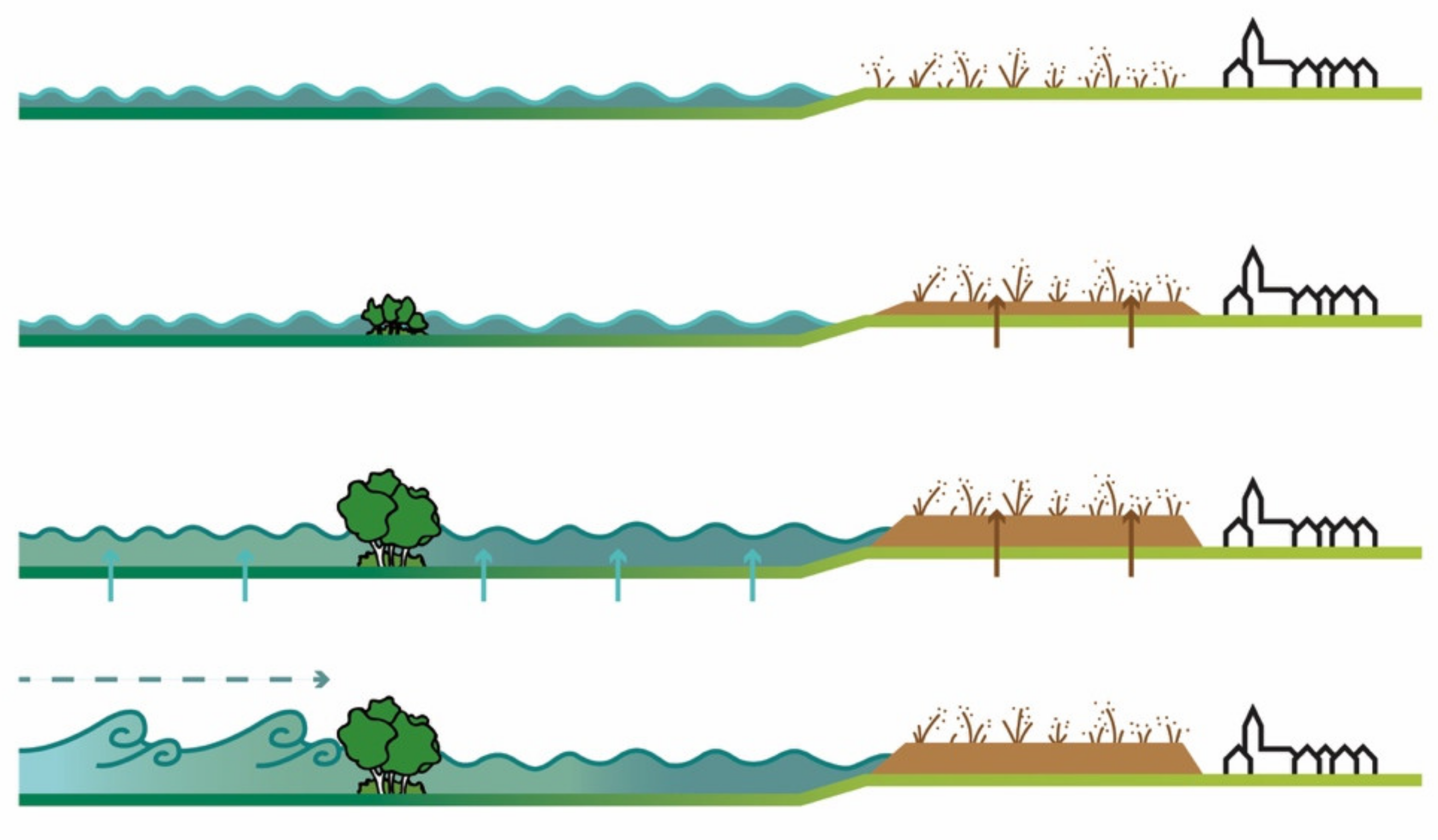

| Name | Principle |
|---|---|
| Barrier island | Natural sea dynamics forming a barrier as an island in front of the coast |
| Creek intrusion | Allowing for saltwater to intrude inland and to expand land forming at sea |
| Terra forming | Allowing the sea water in, but slowing it down on the way back at ebb tide |
| Dutch mangroves | Forests alongside the creeks slowing down the intruding water |
| Ride not crash | Constructed protections preventing the flooding of houses and villages in the landscape during occasional extreme flooding |
| Synaptic fresh-salt | Synergies where salt and fresh water meet, and could form the basis for blue energy |
| Sponge-bog | Sponge operation of the peat landscape |
| Farm Type | Farm Size (m2) | Net Income (Euro/Year) | Type of Produce | Area (m2) Required to Grow Mixed Farms in Order to Get Traditional Farm Income |
|---|---|---|---|---|
| Sugar beet | 200,000 | 47,600 | 30% sugar beet/ 20% seafood/ 50% saline crops | 13,878 (6.5%) |
| Potatoes | 200,000 | 147,600 | 30% potatoes/ 20% seafood/ 50% saline crop | 41,229 (20.5%) |
| Wheat | 200,000 | 21,000 | 30% wheat/ 20% seafood/ 50% saline crops | 6195 (3%) |
| Milk (cow) | 200,000 | 22,000 | 30% cow milk/ 20% seafood/ 50% saline crops | 6471 (3%) |
| Average | 200,000 | 59,550 | 30% existing/20% seafood/50% saline crops | 16,943.25 (8%) |
| Crop | Existing Area Current Land Use (ha) | New Nature (ha) | Area for Existing Crop after Transition (30%) | Area for Sea Food (20%) | Area for Saline Crops (50%) |
|---|---|---|---|---|---|
| Potato | 6875 | 2750 | 1203 | 859 | 2063 |
| Sugar beet | 2475 | 1980 | 186 | 62 | 248 |
| Wheat | 7500 | 6750 | 225 | 150 | 375 |
| Milk cows | 9975 | 8978 | 299 | 200 | 499 |
| Grassland | 9975 | 8978 | 299 | 200 | 499 |
| Carrots | 1200 | 480 | 210 | 150 | 360 |
| Maize | 1860 | 1674 | 55.8 | 37.2 | 91 |
| Barley | 2060 | 1854 | 61.8 | 41.2 | 103 |
| Total (ha) | 41,920 | 33,444 | 2540 | 1700 | 4238 |
| In % | 100% | 80% | 6% | 4% | 10% |
Publisher’s Note: MDPI stays neutral with regard to jurisdictional claims in published maps and institutional affiliations. |
© 2021 by the authors. Licensee MDPI, Basel, Switzerland. This article is an open access article distributed under the terms and conditions of the Creative Commons Attribution (CC BY) license (http://creativecommons.org/licenses/by/4.0/).
Share and Cite
Roggema, R.; Tillie, N.; Hollanders, M. Designing the Adaptive Landscape: Leapfrogging Stacked Vulnerabilities. Land 2021, 10, 158. https://doi.org/10.3390/land10020158
Roggema R, Tillie N, Hollanders M. Designing the Adaptive Landscape: Leapfrogging Stacked Vulnerabilities. Land. 2021; 10(2):158. https://doi.org/10.3390/land10020158
Chicago/Turabian StyleRoggema, Rob, Nico Tillie, and Matthijs Hollanders. 2021. "Designing the Adaptive Landscape: Leapfrogging Stacked Vulnerabilities" Land 10, no. 2: 158. https://doi.org/10.3390/land10020158






